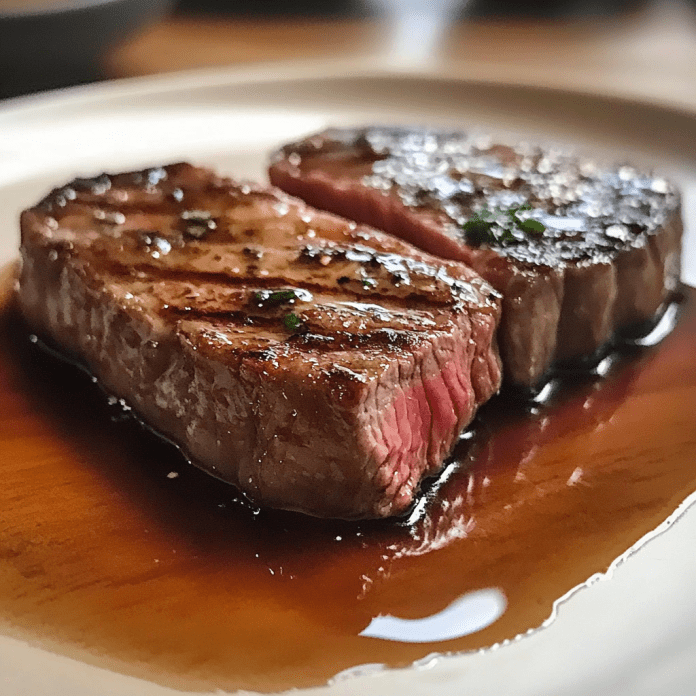When it comes to cooking steak, opinions can be as fiery as the grill itself. I’ve experienced this firsthand in a spirited debate with my sister over steak doneness. I’m convinced I’ve achieved the perfect medium-rare, while she contends it’s undercooked—nearly raw. This culinary disagreement made me ponder: What exactly defines medium-rare? Steak doneness preferences can spark intense discussions around the dinner table, often dividing diners. If you’ve ever found yourself in a similar debate, here’s a guide to help you navigate the subtle differences in steak doneness and arm you with the knowledge to settle any disputes.
Understanding Steak Doneness Levels
Grasping the various doneness levels is crucial to mastering the art of steak cooking. Here’s a detailed overview:
- Rare
A rare steak is quickly seared on the outside but remains cool and predominantly red in the center, reaching an internal temperature of 120°F to 125°F. It’s tender, moist, and has a bold taste that can seem almost primal to some, while others may find it too underdone. - Medium-Rare
Often considered the ideal by steak aficionados, medium-rare steak boasts a warm, red center with an internal temperature of 130°F to 135°F. It strikes a delightful balance between tenderness and flavor, having a well-browned exterior while keeping the inside soft and juicy. This level of doneness is where I claim victory in my culinary clash with my sister. - Medium
For those who prefer less red, medium offers a warm pink center with temperatures between 140°F to 145°F. It’s firmer than medium-rare yet retains a good deal of juiciness and flavor, making it a popular middle ground. - Medium-Well
Cooked to an internal temperature of 150°F to 155°F, medium-well steaks have a slight pinkness at the center. They appeal to those desiring less moisture and a more solid texture, though some steak purists might consider this level approaching overdone. - Well-Done
For a well-done steak, expect no pink at all with temperatures reaching 160°F and above. It’s fully browned throughout, sacrificing juiciness and tenderness for perceived safety. This doneness is often preferred by those cautious of any red in their meat.
Tools and Techniques for Precise Steak Doneness
While personal taste influences steak preferences, achieving consistency is crucial. Here are some tools and methods to ensure you hit your doneness target every time:
- Meat Thermometer: The most accurate way to determine doneness is by using a thermometer. Aim for 130°F for a perfect medium-rare before removing your steak from the heat, keeping in mind that it will continue to cook slightly while resting.
- Touch Test: This old chef’s trick involves comparing the firmness of the steak to the fleshy part of your palm below your thumb when touching different fingers together. This method estimates the steak’s feel at various doneness levels.
- Resting the Steak: Always let your steak rest for 5 to 10 minutes after cooking. This step is essential as it allows the juices to redistribute, ensuring a more tender, flavorful steak.
Navigating Steak Doneness Debates
Misunderstandings about steak doneness can often be resolved with clear communication and understanding that perceptions of ‘perfect’ can vary widely:
- Clearly State Your Preference: When ordering or cooking, specify your preferred doneness clearly. Descriptive phrases like “a warm red center” can provide clearer guidance than just “medium-rare.”
- Visual Aids: Utilize pictures or a doneness chart when explaining your preferences to others, which can help bridge different understandings.
- Keep Practicing: Mastery comes with practice. Experiment with different cooking times and temperatures to familiarize yourself with how steaks cook.
Resolving the Medium-Rare vs. Raw Debate
The key distinction between medium-rare and undercooked lies in the temperature and texture. A medium-rare steak should be warm with a vibrant red center, whereas an undercooked steak might still feel cool inside. If your steak hits the right internal temperature and rests properly, you can confidently claim it’s medium-rare.
Final Thoughts: Embrace Different Tastes
Steak doneness is deeply personal, and achieving a consensus may sometimes mean agreeing to disagree. The essence lies in understanding and respecting diverse preferences and honing your skills to cater to them. Whether it’s reaching a compromise with my sister or cooking multiple steaks to different doneness levels, the goal is to enjoy the journey of culinary mastery.
So, gear up for your next grill session with this knowledge, and remember, the perfect steak is the one that satisfies your taste the most. Happy grilling!


